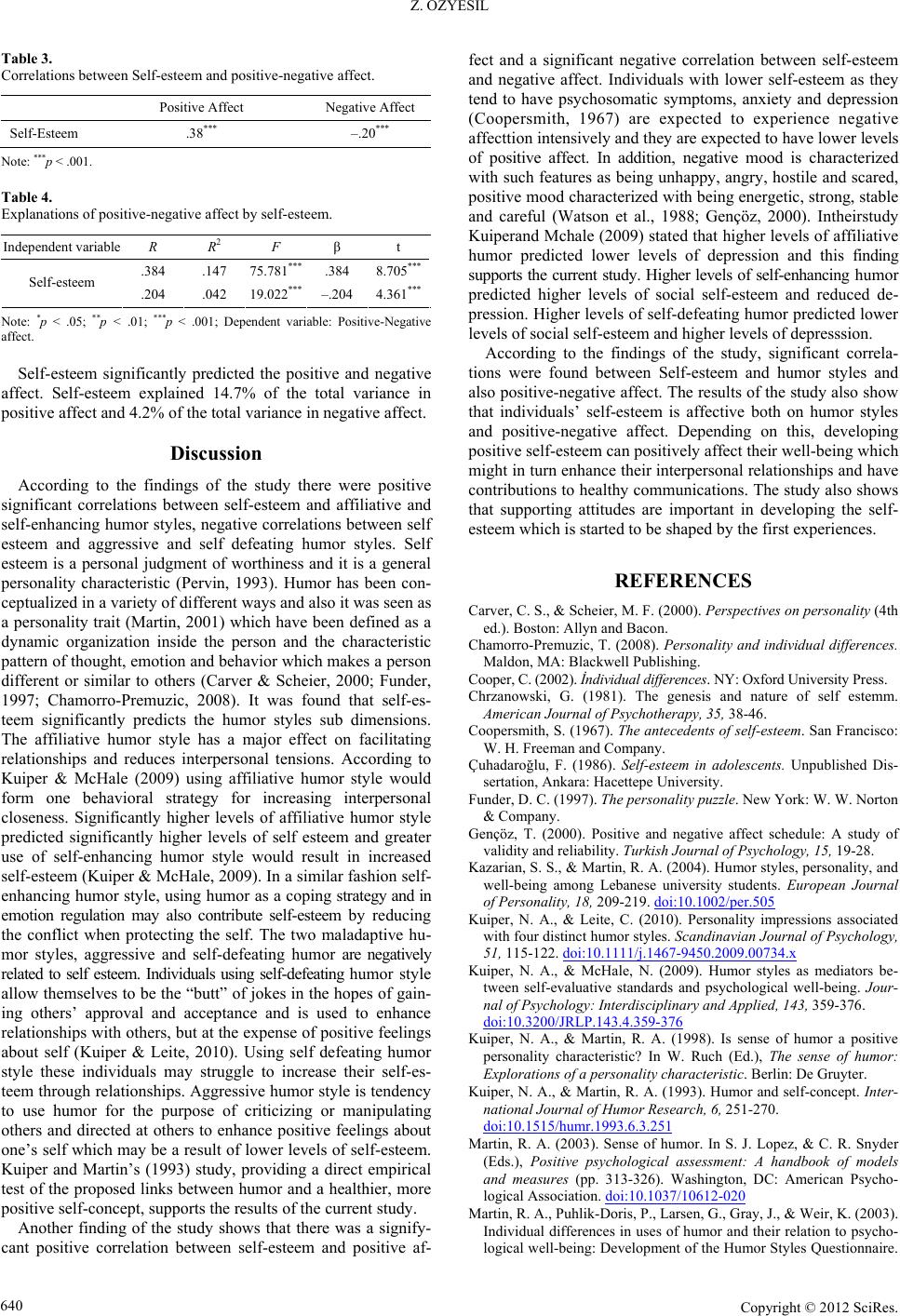
Z. OZYESIL
Table 3.
Correlations between Self-esteem and positive-negative affect.
Positive Affect Negative Affect
Self-Esteem .38*** –.20***
Note: ***p < .001.
Table 4.
Explanations of positive-negative affect by self-esteem.
Independent variable R R2 F β t
.384 .147 75.781*** .384 8.705***
Self-esteem .204 .042 19.022*** –.204 4.361***
Note: *p < .05; **p < .01; ***p < .001; Dependent variable: Positive-Negative
affect.
Self-esteem significantly predicted the positive and negative
affect. Self-esteem explained 14.7% of the total variance in
positive affect and 4.2% of the total variance in negative affect.
Discussion
According to the findings of the study there were positive
significant correlations between self-esteem and affiliative and
self-enhancing humor styles, negative correlations between self
esteem and aggressive and self defeating humor styles. Self
esteem is a personal judgment of worthiness and it is a general
personality characteristic (Pervin, 1993). Humor has been con-
ceptualized in a variety of different ways and also it was seen as
a personality trait (Martin, 2001) which have been defined as a
dynamic organization inside the person and the characteristic
pattern of thought, emotion and behavior which makes a person
different or similar to others (Carver & Scheier, 2000; Funder,
1997; Chamorro-Premuzic, 2008). It was found that self-es-
teem significantly predicts the humor styles sub dimensions.
The affiliative humor style has a major effect on facilitating
relationships and reduces interpersonal tensions. According to
Kuiper & McHale (2009) using affiliative humor style would
form one behavioral strategy for increasing interpersonal
closeness. Significantly higher levels of affiliative humor style
predicted significantly higher levels of self esteem and greater
use of self-enhancing humor style would result in increased
self-esteem (Kuiper & McHale, 2009). In a similar fashion self-
enhancing humor style, using humor as a coping strategy and in
emotion regulation may also contribute self-esteem by reducing
the conflict when protecting the self. The two maladaptive hu-
mor styles, aggressive and self-defeating humor are negatively
related to self esteem. Individuals using self-defeating humor style
allow themselves to be the “butt” of jokes in the hopes of gain-
ing others’ approval and acceptance and is used to enhance
relationships with others, but at the expense of positive feelings
about self (Kuiper & Leite, 2010). Using self defeating humor
style these individuals may struggle to increase their self-es-
teem through relationships. Aggressive humor style is tendency
to use humor for the purpose of criticizing or manipulating
others and directed at others to enhance positive feelings about
one’s self which may be a result of lower levels of self-esteem.
Kuiper and Martin’s (1993) study, providing a direct empirical
test of the proposed links between humor and a healthier, more
positive self-concept, supports the results of the current study.
Another finding of the study shows that there was a signify-
cant positive correlation between self-esteem and positive af-
fect and a significant negative correlation between self-esteem
and negative affect. Individuals with lower self-esteem as they
tend to have psychosomatic symptoms, anxiety and depression
(Coopersmith, 1967) are expected to experience negative
affecttion intensively and they are expected to have lower levels
of positive affect. In addition, negative mood is characterized
with such features as being unhappy, angry, hostile and scared,
positive mood characterized with being energetic, strong, stable
and careful (Watson et al., 1988; Gençöz, 2000). Intheirstudy
Kuiperand Mchale (2009) stated that higher levels of affiliative
humor predicted lower levels of depression and this finding
supports the current study. Higher levels of self-enhancing humor
predicted higher levels of social self-esteem and reduced de-
pression. Higher levels of self-defeating humor predicted lower
levels of social self-esteem and higher levels of depresssion.
According to the findings of the study, significant correla-
tions were found between Self-esteem and humor styles and
also positive-negative affect. The results of the study also show
that individuals’ self-esteem is affective both on humor styles
and positive-negative affect. Depending on this, developing
positive self-esteem can positively affect their well-being which
might in turn enhance their interpersonal relationships and have
contributions to healthy communications. The study also shows
that supporting attitudes are important in developing the self-
esteem which is started to be shaped by the first experiences.
REFERENCES
Carver, C. S., & Scheier, M. F. (2000). Perspectives on personality (4th
ed.). Boston: Allyn and Bacon.
Chamorro-Premuzic, T. (2008). Personality and individual differences.
Maldon, MA: Blackwell Publishing.
Cooper, C. (2002). İndividual differences. NY: Oxford University Press.
Chrzanowski, G. (1981). The genesis and nature of self estemm.
American Journal of Psychotherapy, 35, 38-46.
Coopersmith, S. (1967). The antecedents of self-esteem. San Francisco:
W. H. Freeman and Company.
Çuhadaroğlu, F. (1986). Self-esteem in adolescents. Unpublished Dis-
sertation, Ankara: Hacettepe University.
Funder, D. C. (1997). The personality puzzle. New York: W. W. Norton
& Company.
Gençöz, T. (2000). Positive and negative affect schedule: A study of
validity and reliability. Turkish Journal of Psychology, 15, 19-28.
Kazarian, S. S., & Martin, R. A. (2004). Humor styles, personality, and
well-being among Lebanese university students. European Journal
of Personality, 18, 209-219. doi:10.1002/per.505
Kuiper, N. A., & Leite, C. (2010). Personality impressions associated
with four distinct humor styles. Scandinavian Journal of Psychology,
51, 115-122. doi:10.1111/j.1467-9450.2009.00734.x
Kuiper, N. A., & McHale, N. (2009). Humor styles as mediators be-
tween self-evaluative standards and psychological well-being. Jour-
nal of Psychology: Interdisciplinary and Applied, 143, 359-376.
doi:10.3200/JRLP.143.4.359-376
Kuiper, N. A., & Martin, R. A. (1998). Is sense of humor a positive
personality characteristic? In W. Ruch (Ed.), The sense of humor:
Explorations of a personality characteristic. Berlin: De Gruyter.
Kuiper, N. A., & Martin, R. A. (1993). Humor and self-concept. Inter-
national Journal of Humor Research, 6, 251-270.
doi:10.1515/humr.1993.6.3.251
Martin, R. A. (2003). Sense of humor. In S. J. Lopez, & C. R. Snyder
(Eds.), Positive psychological assessment: A handbook of models
and measures (pp. 313-326). Washington, DC: American Psycho-
logical Association. doi:10.1037/10612-020
Martin, R. A., Puhlik-Doris, P., Larsen, G., Gray, J., & Weir, K. (2003).
Individual differences in uses of humor and their relation to psycho-
logical well-being: Development of the Humor Styles Questionnaire.
Copyright © 2012 SciRes.
640